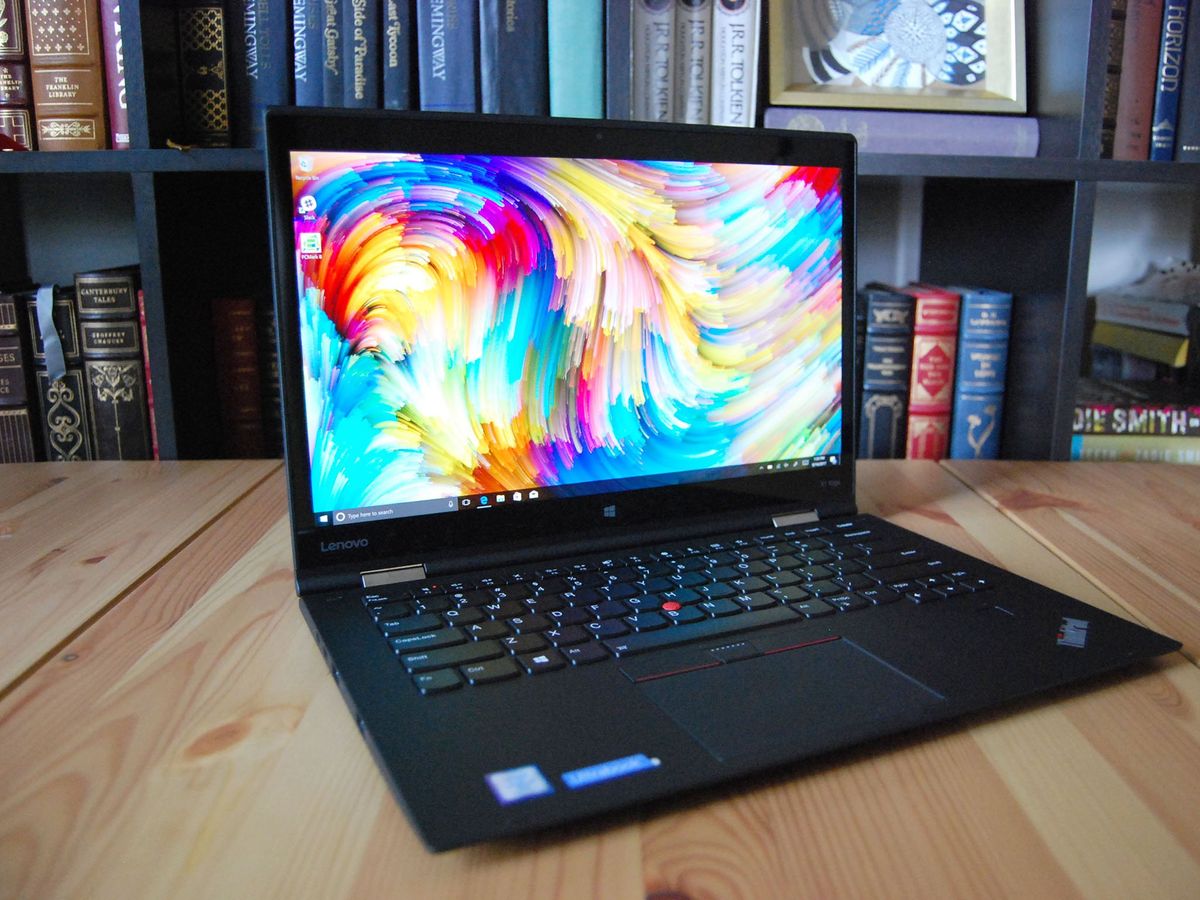
The ThinkPad X1 Yoga can be seen as Lenovo's convertible version of the X1 Carbon, widely regarded as one of Lenovo's finest devices. The X1 Yoga is no slouch either, and we reviewed the 14-inch version with a 1080p IPS display with mid-range hardware inside, awarding it a near-perfect score.

We now have here a 14-inch X1 Yoga with a WQHD (1440p) OLED display and topped out hardware inside. How does the high-res OLED display affect the overall package? Let's take a look in our review.
About this review
Lenovo loaned Windows Central a review unit of the 14-inch ThinkPad Yoga X1 with OLED display. This specific configuration has an Intel Core i7-7600U processor (CPU), 16GB of DDR3 RAM, and a 512GB PCIe solid-state drive (SSD). This exact configuration costs about $2,430.
As reviewed
Lenovo ThinkPad X1 Yoga OLED hardware and specifications
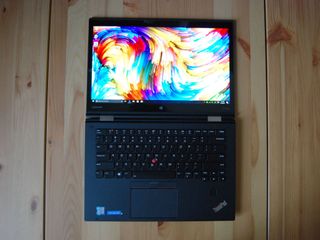
This configuration has maxed out hardware inside and is thus quite expensive. The OLED display itself, if chosen at checkout, only adds about $250 to the final price tag. Here's the hardware inside this review unit.
| Category | XX |
|---|---|
| Processor | Intel Core i7-7600U vPro (up to 3.90GHz)Dual-core |
| Storage | 512GB PCIe SSD(Samsung MZVLW512) |
| RAM | 16GB DDR3-1866MHz |
| Display | 14-inch WQHD (2560 x 1440)OLED, touch, glossy |
| Graphics | Intel HD Graphics 620 |
| Ports | Three USB-A 3.0Two USB-C Thunderbolt 3HDMI 1.4ThinkPad Ethernet extension connector3.5mm jackmicroSD card readerMicro SIM |
| Speakers | Dual 2W speakers |
| Wireless | Intel Dual Band Wireless-AC 8265802.11ac (2 x 2)Bluetooth 4.1 |
| Camera | Front-facing, 720p |
| Touchpad | Precision |
| Pen | ThinkPad Pen Pro |
| Security | Fingerprint reader for Windows HelloDiscrete TPM 2.0Intel vPro |
| Battery | 56WHr |
| Weight | 2.99lbs (1.36kg) |
| Dimensions | 13.11 inches x 9.02 inches x 0.69 inches333mm x 229mm x 17.4mm |
| OS | Windows 10 Pro |
| Color | ThinkPad black |
| Price | About $2,430 |
Vivid
Get the Windows Central Newsletter
All the latest news, reviews, and guides for Windows and Xbox diehards.
Lenovo ThinkPad X1 Yoga OLED display
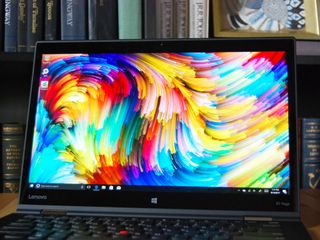
The OLED display found here is manufactured by Samsung, which has a reputation for quality screens. Upon opening the lid, the difference between the regular IPS display and the OLED display is apparent.
The IPS configuration of the X1 Yoga could already hit a decent level of brightness — something many Lenovo laptops cannot do — and the OLED display can do better depending on the situation. Whereas the IPS display has a set maximum for backlight brightness, there are fluctuations here depending on what is displayed.
When displaying white backgrounds, brightness is the lowest. When displaying a black background color, the display is the brightest. When at its brightest, expect about a 15 percent jump over the IPS display, and at its dimmest, expect about 10 percent less than the IPS display. That's just how OLED displays work; nothing out of the ordinary here.
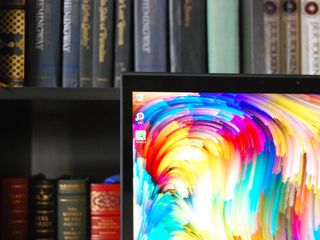
The OLED display also comes with a higher resolution at 2560 x 1440, which really makes the 14-incher come to life. Scaling in all images here is set at 150 percent rather than the recommended 200 percent, which I feel gives plenty more real estate for productivity without making text hard to see.
Color accuracy was about as good as it gets. In testing, we saw 100 percent sRGB, 100 percent AdobeRGB, and 97 percent NTSC. As far as contrast goes, the OLED delivers real black even with brightness cranked right up, and everything is satisfyingly saturated. Love watching movies? You'll almost want to watch them on this display rather than your TV (unless, of course, it's OLED).
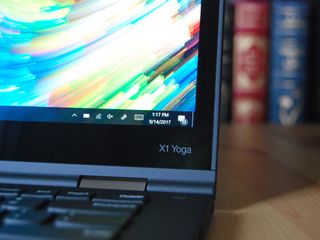
The only issue with OLED and higher resolution is that the battery takes a hit. Whereas the X1 Yoga with 1080p IPS display saw at least eight hours on a single charge, here we saw only about six hours of regular use, and that number would no doubt drop if streaming video or doing a bit of light gaming. Luckily, the battery can take about an 80 percent charge in just an hour through one of the Thunderbolt 3 ports.
As a cherry on top of the OLED sundae, the capacitive ThinkPad Pen Pro can be found docked on the underside of the laptop. It delivers 2,048 levels of pressure for a decent inking experience, and I have no problems using it, other than the fact that I prefer something with a thicker body; this is more like a pencil, whereas I prefer a pen.
Back to black
Lenovo ThinkPad X1 Yoga OLED design
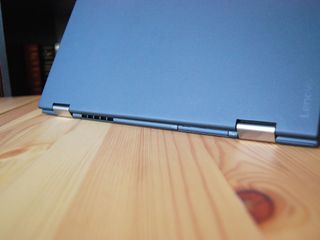
Rather than the silver finish we had on the X1 Yoga with IPS display, we're back to the regular ThinkPad black with the OLED configuration. The paint has the same bit of sparkle as always, and there's a soft feeling to the finish; expect smudges from fingers and palms to show up. The lid is made from a carbon-fiber hybrid, while the bottom is a magnesium-PPS hybrid, giving it a solid feel. Thanks to the OLED display, some weight has been shed. We're now down to 2.99 pounds from 3.15 pounds.
Cutting about 0.16 pounds doesn't seem like a lot, but coupled with the black finish that seems to give the X1 Yoga a much smaller footprint than the silver finish, this is definitely a laptop for anyone who loves a ThinkPad but needs to keep it thin and light. On that note, keep in mind that these laptops are put through 12 MIL-STD 810G tests to ensure that it can take a beating in the field and keep on running.
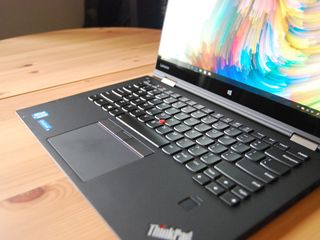
One of the only issues I had with the X1 Yoga in the original review was the way the "Wave" keyboard causes a sort of ratchet feeling when converting the laptop into the tent, stand or tablet modes. The issue is still here, but it's nowhere near a deal-breaker; you'll only feel it in the hinges when moving the lid past about 220 degrees.
Battery suffers
Lenovo ThinkPad X1 Yoga OLED performance


This configuration of the X1 Yoga, on top of the OLED display, comes packed with the top hardware Lenovo offers, so performance was pretty much blazing fast across the board. That performance, though, doesn't come without a high price. Expect to pay just over $2,400 for this exact configuration.
CPU
Geekbench 4.0 Benchmarks (Higher is better)
| Device | CPU | Single core | Multi core |
|---|---|---|---|
| Lenovo ThinkPad X1 Yoga OLED | i7-7600U | 4,439 | 8,189 |
| Lenovo Flex 5 15 | i7-7500U | 3,976 | 7,730 |
| Lenovo Yoga 720 15 | i7-7700HQ | 3,784 | 10,255 |
| Lenovo ThinkPad X1 Yoga (2nd Gen) | i5-7200U | 3,911 | 7,549 |
| Surface Laptop | i5-7200U | 3,725 | 7,523 |
| Lenovo ThinkPad T470 | i5-7300U vPro | 4,394 | 8,580 |
| Dell Latitude 5285 | i7-7600U | 4,635 | 9,289 |
| Lenovo ThinkPad X270 | i7-7600U | 4,512 | 8,566 |
| Lenovo ThinkPad T470s | i5-7300U vPro | 3,919 | 6,077 |
| Lenovo Yoga 720 13 | i5-7200U | 3,881 | 7,509 |
| Lenovo X1 Carbon | i5-7300U | 4,139 | 8,311 |
| HP EliteBook x360 G2 | i7-7600U | 4,496 | 8,435 |
| Samsung Notebook 9 15 Ext | i7-7500U | 4,316 | 8,320 |
| Dell Latitude 7280 | i7-7600U | 4,381 | 7,935 |
| Dell XPS 13 (9360) | i7-6560U | 4,120 | 7,829 |
| HP Spectre 13 | i7-7500U | 4,100 | 7,469 |
| Surface Book | i7-6600U | 3,948 | 7,415 |
The Intel Core i7-7600U CPU handled everything I threw at it and tested quite well in this benchmark. You'll see no issues with everyday tasks.
GPU
Geekbench 4.0 Graphics OpenCL (Higher is better)
| Device | Score |
|---|---|
| Lenovo ThinkPad X1 Yoga OLED | 20,491 |
| Lenovo Flex 5 15 | 16,912 |
| Lenovo Yoga 720 15 | 13,727 |
| Lenovo ThinkPad X1 Yoga (2nd Gen) | 19,738 |
| Surface Pro 2017 | 30,678 |
| Surface Laptop | 19,256 |
| Lenovo ThinkPad T470 | 21,276 |
| Dell Latitude 5285 | 21,921 |
| Lenovo ThinkPad X270 | 17,376 |
| Lenovo ThinkPad T470s | 16,635 |
| Lenovo Yoga 720 13 | 18,185 |
| Lenovo X1 Carbon | 20,932 |
| Dell Latitude 5480 | 21,616 |
| Dell XPS 13 (9360) | 19,410 |
| Surface Book | 18,197 |
| Dell Latitude 7280 | 17,827 |
The integrated Intel HD Graphics 620 can handle a good amount of work, but you'll no doubt want something with dedicated graphics if you're looking for a gaming machine or something that can handle heavy multimedia editing.
PCMark
PCMark Home Conventional 3.0
| Device | Score | Comparison |
|---|---|---|
| Lenovo ThinkPad X1 Yoga OLED | 2,845 | Better than 51 percent of all results |
| Lenovo Flex 5 15 | 2,634 | Better than 46 percent of all results |
| Lenovo Yoga 720 15 | 2,993 | Better than 57 percent of all results |
| Lenovo ThinkPad X1 Yoga (2nd Gen) | 2,773 | Better than 46 percent of all results |
| Surface Pro 2017 | 3,055 | Better than 57 percent of all results |
| Surface Laptop | 2,494 | Better than 40 percent of all results |
| Lenovo ThinkPad T470 | 3,103 | Better than 62 percent of all results |
| Dell Latitude 5285 | 3,079 | Better than 57 percent of all results |
| Lenovo ThinkPad X270 | 3,009 | Better than 57 percent of all results |
| Lenovo ThinkPad T470s | 2,576 | Better than 40 percent of all results |
| Lenovo Yoga 720 13 | 2,717 | Better than 46 percent of all results |
| Lenovo X1 Carbon Core i5 | 2,965 | Better than 57 percent of all results |
| Samsung Notebook 9 15 Ext | 2,998 | Better than 57 percent of all results |
| Dell XPS 15 (9560) | 3,534 | Better than 71 percent of all results |
| Dell Latitude 7280 | 2,829 | Better than 52 percent of all results |
| HP Spectre x360 15 | 2,472 | Better than 41 percent of all results |
The PCMark Home Conventional test takes a bunch of your hardware and determines how well it works together while performing a number of everyday tasks. The ThinkPad X1 Yoga OLED performed quite well, and this score is reflected in usual use. There are no standout issues to report.
SSD
CrystalDiskMark (Higher is better)
| Device | Read | Write |
|---|---|---|
| Lenovo ThinkPad X1 Yoga OLED | 1,213 MB/s | 1,401 MB/s |
| Lenovo Flex 5 15 | 2,146 MB/s | 1,186 MB/s |
| Lenovo Yoga 720 15 | 1,839 MB/s | 1,238 MB/s |
| Lenovo ThinkPad X1 Yoga (2nd Gen) | 1,253 MB/s | 763.6 MB/s |
| Surface Laptop | 423 MB/s | 237 MB/s |
| Lenovo ThinkPad T470 | 1,079 MB/s | 716.1 MB/s |
| Dell Latitude 5285 | 1,300 MB/s | 1,113 MB/s |
| Lenovo ThinkPad X270 PCIe | 1,049 MB/s | 636.9 MB/s |
| Lenovo ThinkPad T470s | 1,557 MB/s | 1,333 MB/s |
| Lenovo Yoga 720 | 1,904 MB/s | 1,169 MB/s |
| Lenovo X1 Carbon | 1,518 MB/s | 1,188 MB/s |
| Samsung Notebook 9 15 Ext | 1,365 MB/s | 1,213 MB/s |
| Razer Blade Pro | 2,571 MB/s | 2,467 MB/s |
| Dell XPS 15 (9560) | 2,207 MB/s | 1,628 MB/s |
| Dell XPS 13 (9360) | 1,287 MB/s | 794 MB/s |
| HP Spectre x360 15 | 1,128 MB/s | 862 MB/s |
The Samsung PCIe SSD here isn't the fastest we've seen in a Lenovo laptop, but it's nevertheless quite speedy. Windows 10 boots almost immediately, apps launch in a snap, and file extraction is fast.
TL;DR
Lenovo ThinkPad X1 Yoga OLED review: Conclusion

We awarded the ThinkPad X1 Yoga with IPS display a 4.5-star rating and a Choice Award, and we're handing out the same score here. While the OLED display is downright gorgeous and a tempting $250 upgrade at checkout, the battery life does take a hit, dropping it down to fewer hours than there are in a workday. For a ThinkPad — a laptop with productivity in mind — that's a bit of an issue.
Yes, this laptop weighs less, and the black finish does seem to give the appearance of a smaller overall footprint, but the issue with the hinges due to the "Wave" keyboard might drive some of you nuts if you're often switching between tablet and notebook modes.
With the perks come drawbacks, but we still have here an attractive convertible laptop that hits performance checkmarks, has a wide selection of ports and continues the legend of the ThinkPad. As mentioned in the first X1 Yoga review, this is a ThinkPad for anyone who needs something that can fit into business and everyday situations.
Pros
- OLED display is beautiful.
- Upgrading to OLED display is $250.
- It weighs less.
- Black finish seems to shrink footprint.
Cons:
- Battery life takes a hit.
- "Wave" keyboard inhibits hinge.
- Very expensive from the start.

Cale Hunt brings to Windows Central more than eight years of experience writing about laptops, PCs, accessories, games, and beyond. If it runs Windows or in some way complements the hardware, there’s a good chance he knows about it, has written about it, or is already busy testing it.